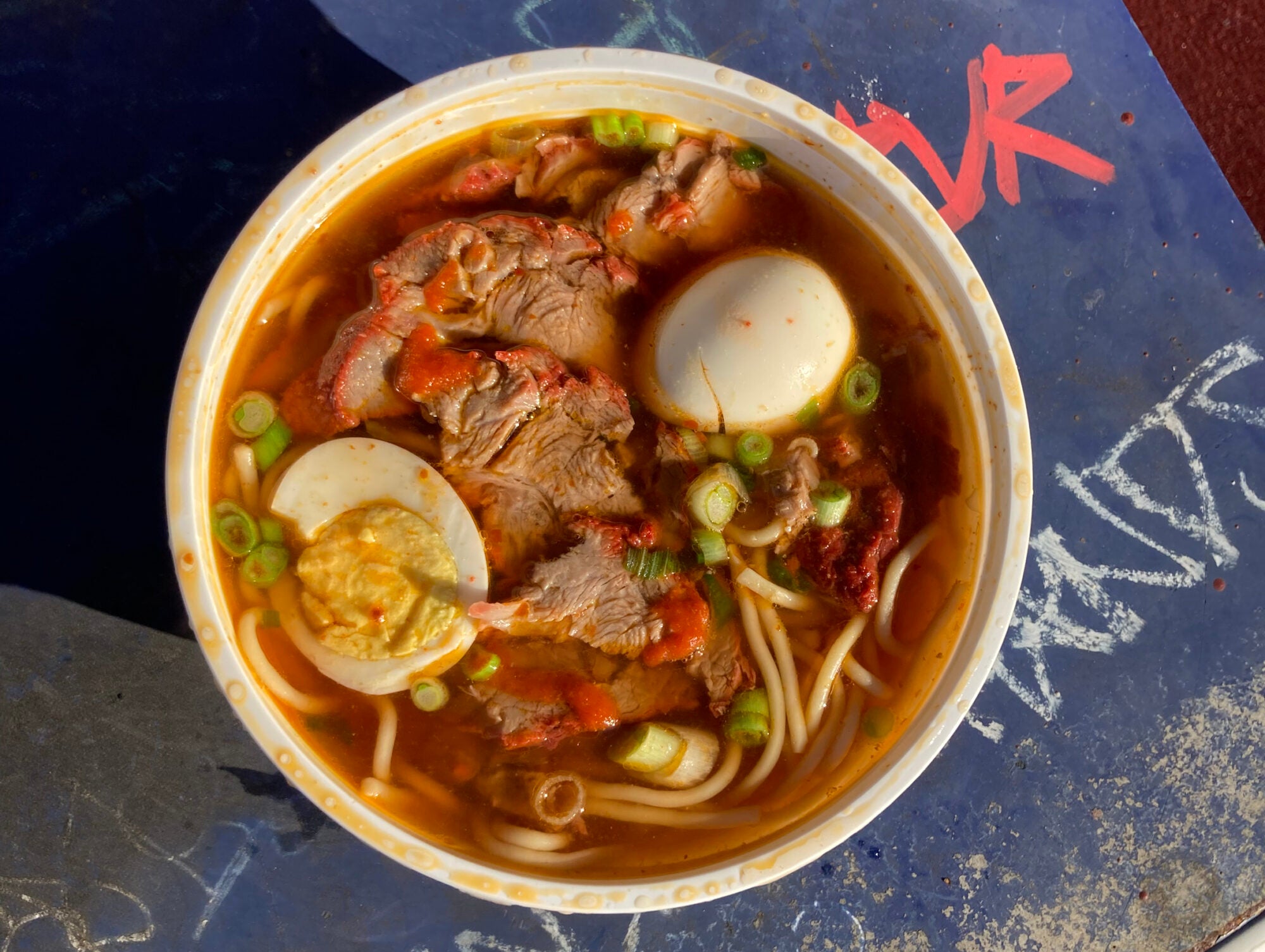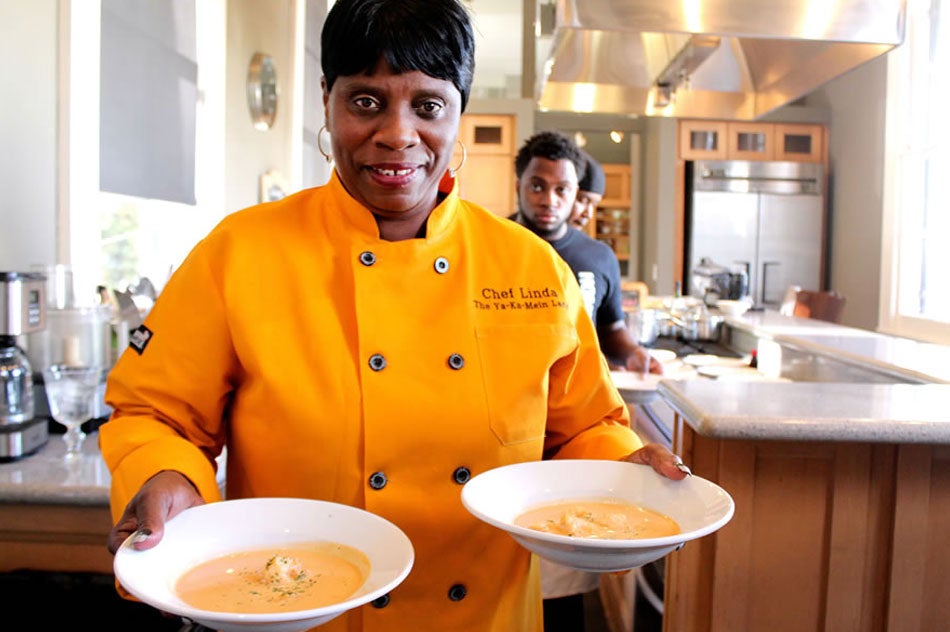
New Orleans is home to many iconic American foods, including a lesser-known bowl of brothy noodles beloved by locals who lean on a serving of “Old Sober” after a night out.
“I tell people all the time that yakamein is one of New Orleans’ best-kept secrets,” says Linda Green, a New Orleans chef who is known across the city as Ms. Linda, the Yakamein Lady. Green began selling yakamein, a powerfully savory, meaty Chinese and African American noodle soup with conflicting origin stories, at second line parades after Hurricane Katrina in 2005. Also called “Old Sober,” the salty broth is beloved as a high-sodium hangover cure.
Green keeps her recipe for yakamein a secret, but the main components are always the same: broth or “juice” (classically beef, infused with soy sauce and spices), wheat noodles (usually spaghetti), a hard-boiled egg, and some kind of protein (everything from chicken and oysters to alligator and duck, but shrimp and beef are the most popular). The bowl is usually finished with a dash of hot sauce and a scattering of fresh scallions—and sometimes additional packets of soy sauce.
Green had lost her job as a cafeteria worker in the New Orleans public school system when the schools shut down in the wake of the disaster, and she needed to find a new way to support herself and her family. She explained that her mother and her grandmother had made yakamein for years and passed their recipe down to her. “A lot of people died with that recipe,” she said. “We didn’t let my mom and my grandma die with it.”
Yakamein won’t be a secret outside of New Orleans much longer. Its star is rising, along with Ms. Linda’s. In 2022, Green was featured in an episode of Netflix’s Street Food: USA that focused on the iconic foods of New Orleans. A number of standard New Orleans dishes have a much higher profile outside the city than yakamein: gumbo, jambalaya, po’ boys, beignets, bananas foster. These foods are preserved, and sometimes reinterpreted, all over New Orleans—and exported around the world by people who love the city and its culture. But yakamein, until recently, was harder for visitors to find.
“It is a Chinese dish. And it’s an African American dish too,” says Green. “It was a poor man’s dish . . . and we kept it in our kitchens, and we kept it in our African American bars.” The oft-repeated theory is that yakamein originated in New Orleans’ Chinatown, in the immigrant restaurants that opened there in the 19th century. Somewhere along the way, it was adopted by black cooks and restaurateurs and became incorporated into soul food. “Back in the slave days, [Chinese and African Americans] were in the same kitchen, cooking together,” says Green. “We took it, but we put our own spices and herbs in.”
Winston Ho, an independent historian in New Orleans whose research has focused on the history of yakamein, explains that the dish has had many lives, being adapted over time according to the culture of the people preparing it. “This is something that started out in the New Orleans Chinatown and somehow migrated into African American soul food, and then yakamein died out on these old Chinese restaurant menus, maybe in the 1970s, around the same time that chop suey went out of style,” he says. “It was preserved in restaurants that serve it to African Americans, and African Americans created their own version of yakamein.”
“Back in the slave days, [Chinese and African Americans] were in the same kitchen, cooking together.”
I tried Green’s yakamein at the Luna Fete art and lights festival in December 2022. It was an uncommonly cold night in New Orleans, and her stand was the only one with a line of people waiting to buy the food. I watched her ladle broth into a Styrofoam cup spilling over with spaghetti and beef. Then she poured the broth out, using her giant ladle to hold the ingredients back, and refilled it, repeating this process one, two, three times before serving the bowl of noodle soup, garnished with scallions and finished with a dash of Louisiana Crystal hot sauce. “The reason I do it like that is I want the noodles at the bottom to be hot too,” she explains. “I want the whole cup to be hot.”
Before she began filling my cup with broth, she spooned a few drops into the palm of her granddaughter’s hand. Her young assistant tasted it, paused, and nodded sagely, approving of the flavor. Green told me that her granddaughter, who is sixteen and learning the business, has been cooking yakamein since she was three. “This is her legacy,” she says. “My mother always said, ‘When you cook for taste, they keep coming back, because they like what you got.’ And that’s what I tell my grandchildren.”
Green’s granddaughter is training in the family tradition, but the next generation of yakamein will take many forms. “A lot of the food stores [in New Orleans] are run by Vietnamese people,” Ho explains. “Just like the Chinese immigrants, their customers are telling them what yakamein is. So the Vietnamese create their own version of yakamein, something they [themselves] would like to eat,” he says. “So now we’ve got Chinese yakamein, Creole yakamein, and Vietnamese yakamein, and all three of these versions bear very little resemblance to that original yakamein that was ubiquitous in Chinatown [in the early 1900s]. . . . That version of yakamein doesn’t really exist anymore.”
On one of my last days in New Orleans, I tried yakamein from John and Mary Food Store in the Fifth Ward. Cuong Tran, the owner, came to Louisiana from Vietnam in 1987. He opened his business in 2009, and he learned to cook yakamein from people here in New Orleans. Tran serves a large bowl of yakamein with Chinese-style BBQ pork, and the clear broth—much lighter in color and flavor than Green’s soy-sauce-infused juice—was tinged with red from the char siu.
Yakamein’s many iterations tell a story of how a city has changed over time—a city that has always been defined by its diversity and its mixing of cultures. The dish’s origins are rooted in a time when New Orleans’ black and Chinese residents lived side by side, eating and adapting one another’s cuisine. Today a new wave of immigrants, many from Vietnam and Southeast Asia, are becoming involved in that process of change. Yakamein’s future is yet to be written. But one thing is unlikely: that it will disappear.
